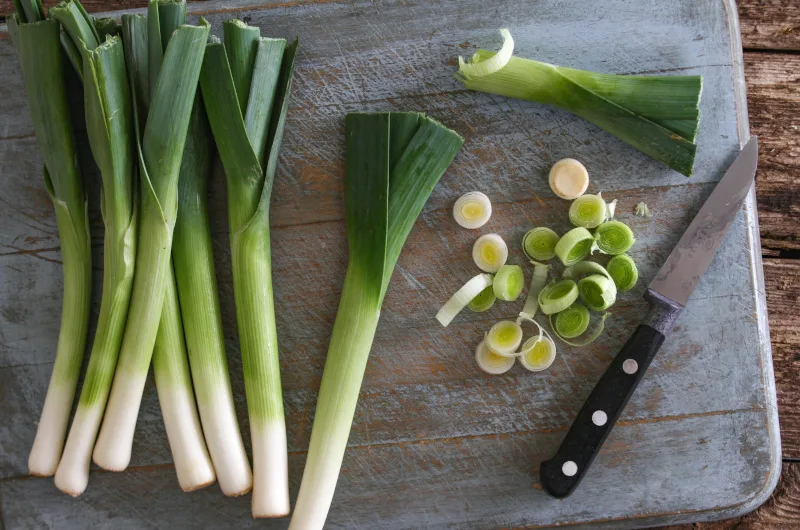How To Grow Leeks
Leeks, with their mild and onion-like flavour, have long been a staple in British cuisine, and especially in Wales. Accoding to Discover Wales, “This root vegetable is so well established as part of Welsh culture that wearing a leek to signify you come from Wales is noted as an ‘ancient tradition’ in William Shakespeare’s Henry V, first performed in the 16th century”.
These versatile vegetables are not only delicious but also relatively easy to grow in your own garden. If you’re a gardening enthusiast or simply want to try your hand at cultivating these delectable delights, this guide will provide you with all the necessary information on how to successfully grow leeks.
Selecting the Right Site and Soil
Before diving into the planting process, it’s essential to choose the right site for your leek patch. Leeks thrive in well-drained soil that has been enriched with compost or well-rotted manure. They prefer a sunny location but can tolerate partial shade, making them adaptable to various garden layouts.
Planting Process
- Prepare the Soil: Start by preparing the soil in the chosen area. Loosen the soil to a depth of around 12 inches (30 cm) using a fork, ensuring that it’s free from large clumps and rocks.
- Create Planting Holes: Leeks are traditionally grown in trenches or planting holes. Using a dibber (a pointed gardening tool), make holes in the soil about 6 inches (15 cm) apart in rows that are also 6 inches apart. The holes should be roughly 6 inches deep.
- Seeds or young plants? Leeks can be grown from seed or shop bought seedlings. If starting from seed, sow them indoors in early spring, and once they’re around 6 inches tall, transplant them to your garden. If you buy seedlings from a garden centre or mail order supplier, plant them directly into the prepared holes, making sure they sit comfortably without bending.
- Planting Technique: Gently drop a leek transplant into each hole, ensuring that the roots are well within the hole. If you’re planting seeds, carefully thin them to avoid overcrowding as they grow.
- Watering: After placing each seedling into its hole, give your leeks a good watering to help settle the soil around the roots. Maintain consistent moisture throughout the growing season, but be cautious not to overwater, as leeks don’t thrive in waterlogged soil.
- Hilling Up: As your leeks grow, you can gradually fill in the holes with soil to blanch the stems. This will result in the characteristic long, white portion of the leek.
Root Cutting Dilemma
One common question that arises during leek cultivation is whether or not to cut the roots before planting. Some gardeners believe that trimming the roots before planting can help the leeks establish themselves better. However, this practice is not necessary. Leeks have a remarkable ability to regenerate their roots, and cutting them might actually stress the plant. Therefore, it’s advisable to leave the roots intact and focus on proper planting techniques and post-planting care for optimal results.
Post-Planting Care
Mulching: Apply a layer of mulch around your leeks to retain moisture, suppress weeds, and maintain an even soil temperature.
Fertilisation: Leeks benefit from a balanced fertiliser applied a few weeks after planting. Avoid over-fertilising, as excessive nitrogen can lead to lush foliage but smaller bulbs.
Thinning: If you’ve planted leek seeds, thin them when they’re around pencil thickness to ensure they have enough space to grow properly.
Pest and Disease Control: Keep an eye out for common leek pests like aphids and onion flies. Regularly inspect your plants and use appropriate measures if any issues arise.
Harvesting
Leeks are typically ready for harvest in late summer or early autumn, depending on when you planted them. You can start harvesting once the stems are about 1 inch (2.5 cm) or more in diameter. If you keep them well protected from predators (especially rabbits, who’ll love making a meal of them as winter sets in!) leeks will stand up to a fair amount of cold, so can be harvested well into winter.
To harvest, gently loosen the soil around the leek’s base and pull it out of the ground. Leeks form a big, bushy crop of roots, which can make them hard to pull up if the ground is heavy. Take care and apply firm but steady pressure to release them from the soil, taking care not to snap them off. The white and light green portions are the most desirable for culinary use.
Final Thoughts
Growing leeks can be a rewarding experience for any gardener, whether novice or experienced. By creating the perfect planting environment, choosing the right planting technique, and providing appropriate care, you’ll be able to enjoy a bountiful harvest of these flavourful vegetables. We love them in a good, strong cheese sauce. On a cold winter’s day, a good piece of steak, mashed potatoes and leeks in cheese sauce is a fabulously hearty dish to stave off the cold. There are however countless other ways to enjoy them; from soups, to stir-fries.



